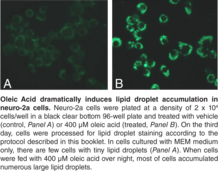| References |
| Stability |
1 year |
| Storage |
-20°C |
| Shipping |
Wet ice
in continental US; may vary elsewhere
|
Background Reading
Listenberger, L.L., and Brown, D.G. Fluorescent Detection of Lipid Droplets and Associated Proteins. Curr Protoc Cell Biol Supplement 35 24.2.1-24.2.11 (2007).
D'Avila, H., Maya-Monteiro, C.M., and Bozza, P.T. Lipid bodies in innate immune response to bacterial and parasite infections. Int Immunopharmacol 8 1308-1315 (2008).
Martin, S., and Parton, R.G. Lipid droplets: a unified view of a dynamic organelle. Nat Rev Mol Cell Biol 7 373-378 (2006).
| Size |
Global Purchasing |
| 480 tests |
|
Description
Lipid droplets are lipid storage organelles found in the cytoplasm of most eukaryotic cells. The storage of lipids in mammalian cells was long considered to occur mainly in adipocytes and steroidogenic cells. Lipid droplets were treated as inert organelles in which excess fatty acids were converted to neutral lipids to be used for metabolism, membrane synthesis (phospholipids and cholesterol), and steroid synthesis. Further evidence demonstrates that lipid droplets are complexes composed of lipids together with PAT proteins, including Perilipin (P), adipophilin (A), and tail-interacting protein of 47 kDa (TIP 47, T). Lipid droplets are a fundamental component of intracellular lipid homeostasis in all cell types, and they can provide a rapidly mobilized lipid source for many important biological processes such as membrane trafficking and cell signaling.1,2 In fact, lipid droplet formation is cell and stimulus specific and is highly regulated. New lipid droplets are synthesized in the course of a variety of immunopathological conditions, especially during inflammation. The emerging role of lipid droplets as inflammatory mediators raises lipid droplets to key markers of leukocyte activation and attractive targets for novel anti-inflammatory therapies.1 Cayman’s Lipid Droplets Fluorescence Assay Kit can be used to study regulators of lipid droplet biogenesis in a variety of conditions, including inflammation. The main advantage of this assay is that the green fluorescence of Nile Red is both very sensitive and specific for lipid droplets.3 Furthermore, changes in lipid droplet biogenesis in various cell types in response to different manipulations can be both qualified and quantified by fluorescence microscopy, flow cytometry, or fluorescence plate readers. Simultaneous visualization of lipid droplets and associated proteins is also possible when used with an antibody conjugated to a blue fluorophore. Oleic acid, which is commonly used to induce lipid droplet formation in cultured cells, is included as a positive control. This kit provides sufficient reagent to effectively treat/stain 480 individual wells of cells when utilized in a 96-well plate format. Lower density plates will still require approximately the same amount of reagent on a per plate basis. Therefore, in effect 5 plates worth of cells can be examined irrespective of the number of wells/plate. Exceptions include protocols in which non-adherent cells are utilized.
1
D'Avila, H., Maya-Monteiro, C.M., and Bozza, P.T. Lipid bodies in innate immune response to bacterial and parasite infections. Int Immunopharmacol 8 1308-1315 (2008).
2
Martin, S., and Parton, R.G. Lipid droplets: a unified view of a dynamic organelle. Nat Rev Mol Cell Biol 7 373-378 (2006).
3
Listenberger, L.L., and Brown, D.G. Fluorescent Detection of Lipid Droplets and Associated Proteins. Curr Protoc Cell Biol Supplement 35 24.2.1-24.2.11 (2007).
|






